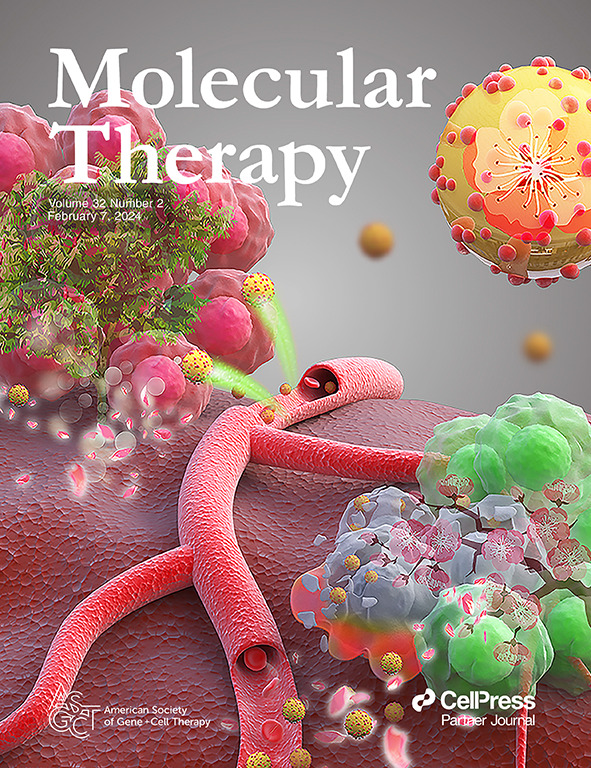在小鼠和人肝细胞中通过条形码AAV文库的活体生物筛选鉴定一个健壮的启动子。
IF 12.1
1区 医学
Q1 BIOTECHNOLOGY & APPLIED MICROBIOLOGY
引用次数: 0
摘要
重组腺相关病毒(AAV)是体内人类基因疗法的主要载体。启动子是一种不可或缺的载体元件,它可以控制转基因以普遍存在或细胞类型选择性的方式表达。确定最佳的囊壳-启动子组合具有挑战性,尤其是在考虑靶上表达与脱靶表达时。在这里,我们报告了一种基于 AAV 胶囊条形码技术的 AAV 体内启动子生物筛选方法,并通过使用 AAV9 载体在 16 种鼠组织中筛选 53 个启动子来说明其潜力。令人惊讶的是,2.2 kb 的人神经胶质纤维酸性蛋白(GFAP)启动子在肝脏中的命中率最高,其表现优于人α-1-抗胰蛋白酶启动子或临床使用的肝脏特异性启动子 1(LP1)等稳健基准。对肝细胞群的分析表明,肝细胞中的 GFAP 启动子更具有活性。值得注意的是,在移植到免疫缺陷小鼠体内的人类肝细胞中,GFAP 启动子的活性也超过了 LP1 和巨细胞病毒(CMV)启动子。这些发现使 GFAP 启动子成为一种令人兴奋的选择,可用于需要在肝细胞中高效、特异性表达转基因的研究和临床应用。我们的产品线扩展了病毒载体成分高通量体内筛选的技术库,并与囊壳条形码兼容,有助于对复杂的 AAV 文库进行组合检测。本文章由计算机程序翻译,如有差异,请以英文原文为准。
Identification of a robust promoter in mouse and human hepatocytes by in vivo biopanning of a barcoded AAV library.
Recombinant adeno-associated viruses (AAV) are leading vectors for in vivo human gene therapy. An integral vector element are promoters, which control transgene expression in either a ubiquitous or cell-type-selective manner. Identifying optimal capsid-promoter combinations is challenging, especially when considering on- versus off-target expression. Here, we report a pipeline for in vivo promoter biopanning in AAV building on our AAV capsid barcoding technology and illustrate its potential by screening 53 promoters in 16 murine tissues using an AAV9 vector. Surprisingly, the 2.2 kb human glial fibrillary acidic protein (GFAP) promoter was the top hit in the liver, where it outperformed robust benchmarks such as the human alpha-1-antitrypsin promoter or the clinically used liver-specific promoter 1 (LP1). Analysis of hepatic cell populations revealed preferred GFAP promoter activity in hepatocytes. Notably, the GFAP promoter also surpassed the LP1 and cytomegalovirus (CMV) promoters in human hepatocytes engrafted in an immune-deficient mouse. These findings establish the GFAP promoter as an exciting alternative for research and clinical applications requiring efficient and specific transgene expression in hepatocytes. Our pipeline expands the arsenal of technologies for high-throughput in vivo screening of viral vector components and is compatible with capsid barcoding, facilitating the combinatorial interrogation of complex AAV libraries.
求助全文
通过发布文献求助,成功后即可免费获取论文全文。
去求助
来源期刊

Molecular Therapy
医学-生物工程与应用微生物
CiteScore
19.20
自引率
3.20%
发文量
357
审稿时长
3 months
期刊介绍:
Molecular Therapy is the leading journal for research in gene transfer, vector development, stem cell manipulation, and therapeutic interventions. It covers a broad spectrum of topics including genetic and acquired disease correction, vaccine development, pre-clinical validation, safety/efficacy studies, and clinical trials. With a focus on advancing genetics, medicine, and biotechnology, Molecular Therapy publishes peer-reviewed research, reviews, and commentaries to showcase the latest advancements in the field. With an impressive impact factor of 12.4 in 2022, it continues to attract top-tier contributions.
 求助内容:
求助内容: 应助结果提醒方式:
应助结果提醒方式:


